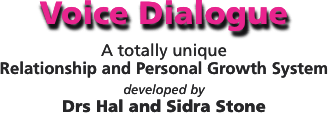Issue 29
THE SECOND ELEMENT
THE PSYCHOLOGY OF SELVES
The Beginnings of Theory
It is difficult to remember how and when our theoretical considerations began to intermix with our deeply personal work. We were both psychologists (practicing psychotherapists). Things were happening and changes were taking place with remarkable speed and, quite naturally, we began to organize our thinking about the events that were occurring.
The first realization to come to us was that these selves inside of us behaved like real people and that they had to be treated with the greatest respect. If they sensed that they were being judged in any way or manipulated in any way, they withdrew. It also became clear very early that for a self to remain with the facilitator, the facilitator had to remain totally present – the self required a strong energetic connection to hold it. This was long before our more sophisticated development of the energetics of Voice Dialogue. It was, however, a beginning.
PRIMARY AND DISOWNED SELVES
Very early in our explorations we began to see that we are made up of primary selves – a group of selves that define our personality. (We had some question as to whether we should call them primary or dominant selves and we settled on primary.) It seemed to us like a very simple idea. Why hadn’t we ever been able to see this before? Who we think we are is really a group of selves that we have identified with and these selves become the persona or how we present ourselves to the world.
The next step seemed quite natural and obvious as we continued our work with each other. Whenever we identify with a primary self then on the other side, equal and opposite, is its opposite. We called this the disowned self. Nathaniel Branden had first coined this term – the disowned self. When he talked of the disowned self, he was referring, however, to the disowned self as the emotions that are disowned by people who identify with the mind and have a basically rational approach to life. We spoke with Nathaniel about all of this and he was comfortable with our using this term. We are grateful to him for his largesse in this matter because the terms disowned and primary selves fit together so perfectly.
Within the first few years, these ideas were getting pretty well set. In the earliest years, we used the idea of a Protector-Controller as the main primary self, the self that set up the basic rules and was the guardian of the gates of entry to our inner world. We saw the Protector/Controller as a self that gathered and organized information about the world around us so that we could understand it, a self that protected us, and controlled both our behavior and our environment.
It took time before we realized that this was a generic term and that every primary self was a protector and a controller in its own way, that each had its own way of figuring out the world around us, and that each primary self lived by its own set of rules. The Protector-Controller is still used by many teachers and is still a very good self to use at the beginning of Voice Dialogue. It provides us with a picture of what clinicians often refer to as the basic defense structure of the personality.
We, however, don’t think in terms of defenses; instead we think of the primary selves in terms of their adaptability and creativity – we honor their attempts to contribute to a person’s wellbeing. We always saw them as selves that were central to survival, accomplishment, and the ability (however limited) to relate to others — and, therefore, always to be regarded with the greatest degree of respect.
WORKING WITH OPPOSITES
After the first excitement of exploring individual selves, and after the ideas of primary and disowned selves began to emerge, we began in our work together to work more and more with opposites. This happened gradually because in the earliest phase of our work we enjoyed concentrating on a single self. We spent a great deal of time working with the Inner Child, the Inner Critic, the Responsible Parent, the Observing Mind, and the Protector/Controller. And we had a good deal of fun and there was much action when we talked with the disowned selves. Those selves were a lot more adventurous and rambunctious, often quite intense – and totally irreverent.
We began to see, however, that the real gift of the work was not simply talking to selves. Instead, we began to get the sense that the real point of the work was working directly with opposites. It seemed important to learn how to separate from the primary selves, to talk with the disowned selves, and then learn to stand between the opposites (of the primary and disowned selves) clearly feeling both at the same time. It was the opposites that were important.
It took time for this shift in emphasis to occur because talking to many voices, and especially to the disowned selves, was so much fun. As time passed, we increasingly put our emphasis on working between the opposites. But something was missing – we needed to address the issue of a model of consciousness that could encompass all of this.

